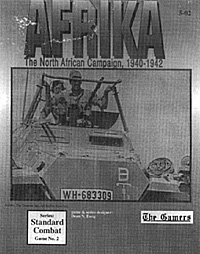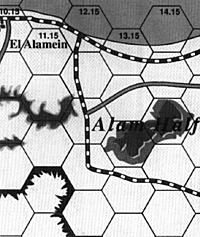 The wargame as originally conceived was
a way to simulate battle without the unnecessary
expenditure of life and property. Since its
beginnings in eons past Oust after Richard Berg
designed his first game!) the wargame has gotten
more complex and sophisticated, evolving into
the colorful, even artistic package typically
published by The Gamers, GMT, XTR, and
even humble GameFix. However, despite all the
color and complexity, a wargame must still give
players an accurate "feel" for the conflict. To
accomplish that, the game must accurately
display the military doctrine employed
historically. If it does not, then you are may have
a great time playing a game, but it is not a wargame.
The wargame as originally conceived was
a way to simulate battle without the unnecessary
expenditure of life and property. Since its
beginnings in eons past Oust after Richard Berg
designed his first game!) the wargame has gotten
more complex and sophisticated, evolving into
the colorful, even artistic package typically
published by The Gamers, GMT, XTR, and
even humble GameFix. However, despite all the
color and complexity, a wargame must still give
players an accurate "feel" for the conflict. To
accomplish that, the game must accurately
display the military doctrine employed
historically. If it does not, then you are may have
a great time playing a game, but it is not a wargame.
War, like many other human endeavors, is a very stylized proposition. Military men around the world are taught the basics of war, including how to use their weapons, how to move about in mass, usually called drill, and the basics of living in the woods. Each country adds to these basic teachings by creating a military doctrine that tells all the soldiers exactly how they will fight, how they will employ their weapons, and where they will go on the battlefield.
All ground commanders, for instance, are taught that roughly a third of their force must be kept in reserve. Platoon commanders arrange their three squads so that two are forward and one is held back, effectively creating a reserve platoon. Higher-ups at each level arrange their formations in a similar manner.
The use of reserves gives an officer the ability to move reinforcements forward, if and when the enemy is encountered. This practice is taught at every level of military training. In fact, at the higher Command and Staff Colleges, division and corps commanders are taught that one of their primary responsibilities is knowing when to commit the reserve force to battle.
The reserve is central to the doctrine practiced by every military organization in the world. Yet have you ever seen a wargame that requires a player to maintain a reserve or seen a special rule designed to show the power of such a force on a given battle? Don't be surprised if you can't recall one; they are very few and far between.
Take, for example, the Gamers Inc.'s Afrika: The North African campaign 1940-1942. The game, beautifully designed, features plenty of exciting rules covering many of the important phases of desert warfare during WWII. The game includes an Exploitation Phase to simulate armored warfare, Truck Points to move supplies, Air Support, Divisional Integrity, Combined Arms, the "Long Range Desert Group," and scores of other nice touches that allow the player to simulate most of the important facets of the campaign in North Africa. However, there are no provisions for the creation or use of reserves.
In most games, the reserve is clearly evident. It is one or several units, depending on the game's scale, a few hexes behind the front lines. Referring again to Afrika, you can clearly see the British reserve units forming during the First Battle of El Alamein (Scenario 3).
The 1st Armored Division located in hex 12.13 is clearly poised to act as the British reserve for the battle. It is concentrated at a strategic crossroads where it can meet any Axis attack on the El Alamein line or flanking maneuver around it. First Armored is the unit that will decide the battle of El Alamein for the British. However, since there are no rules to cover its use, it is almost a certainty that the British player will simply move the unit forward to strengthen the defensive line.
Many designers have argued that, above the platoon/company level reserves, are "factored into" printed unit strengths and the combat results table. A designer can certainly represent the reserve at any level by simply factoring out 33% of a unit's combat strength. Although such designs may technically represent the existence of reserves, they do not cover their military application. The reserve is not simply an extra body of men: for the defense, it represents the commander's ability to shore up the line just before an enemy breaks through; on the offensive, it is the final push that will propel the attackers to victory.
The reserve is considered so important that reconnaissance elements of modern armies spend a great deal of time searching for the location of reserves. Once they are found, the commander has a much better idea of where to attack or how to defend. Giving all the units on the map a reserve completely misses the point, since it is concentration and choice that lie at the heart of military decision-making and success on the battlefield.
 How, then, can the problem be handled?
Designers could include a rule that allows
commanders to commit their reserve by simply
stating that fact. The player would then receive
an advantage on the combat resolution table for
the upcoming attack or defense. If the action
succeeded, it would represent the commander
throwing the total weight of his forces into the
fray.
How, then, can the problem be handled?
Designers could include a rule that allows
commanders to commit their reserve by simply
stating that fact. The player would then receive
an advantage on the combat resolution table for
the upcoming attack or defense. If the action
succeeded, it would represent the commander
throwing the total weight of his forces into the
fray.
If it failed, the rules could reflect a penalty, such as no attacks or a reduced defensive factor for reserve units on the next turn. Because commanders are required to reconstitute their reserve as quickly as possible, the reserve for each side would likely return to full effectiveness in a turn or two, at least in a 20th-century situation.
This, of course, is an oversimplification. Because both players have reserves, the defending player would send reserves into the same combat in which the opponent just committed its reserves. The net effect might be treated like the stylized air power counters of some of the old SPI games. You commit your airpower; I neutralize it with mine. Gee, that was fun! (Well, not really .. )
More interesting and imaginative outcomes are possible. The designer could allow the reserves to be committed to a given combat and waive the stacking restrictions for that combat on the turn of commitment. A special column on the odds chart could reflect the desperate nature of a combat by increasing the casualties suffered by either side if reserves are used. Once a combat involving reserves is resolved, the reserve would have to be withdrawn and reconstituted. Rules covering increased supply costs or limited ability to attack on the next turn could adequately reflect the cost of reconstituting the reserve.
Whatever rules are decided upon, one thing is certain: Because the reserve is such an integral part of military doctrine, it should be on the map and highly visible. Reserves should be designated, perhaps with a special marker. A player in his or her role as commander at a particular scale should only be concerned with the reserves at the appropriate level.
For example, all things being equal, a battalion commander would have a reserve company, and an army general would receive a corps. The key point to bear in mind is that there would only be one reserve unit (or group of organizationally related units) with which the player/commander would be concerned.
With the addition of a few simple rules, a vital and currently overlooked part of military doctrine could be added to a wide array of print wargames. (Other genres, including computer games, would also benefit.) The simulation of the reserve would add realism along with some guesswork and "fog of war, which would encourage greater use of intelligence gathering rules- a welcome added benefit. These are key elements that deserve to be added to practically any wargame, regardless of size or level of complexity. The would make the games more accurate, more fun, and add a crucial aspect of real military doctrine so often lacking in past designs.
Back to Table of Contents GameFix # 7
Back to Competitive Edge List of Issues
Back to Master Magazine List
© Copyright 1995 by One Small Step, Inc.
This article appears in MagWeb.com (Magazine Web) on the Internet World Wide Web.
Other articles from military history and related magazines are available at http://www.magweb.com